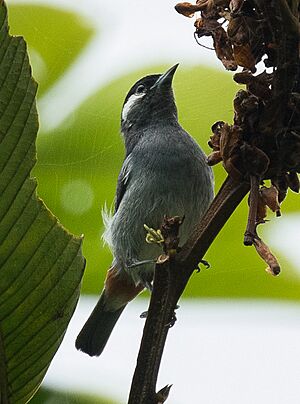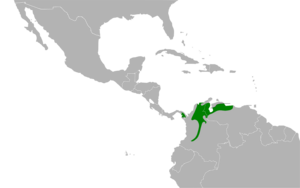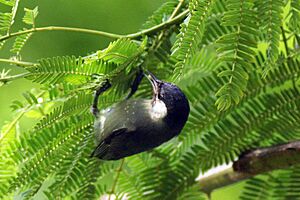White-eared conebill facts for kids
Quick facts for kids White-eared conebill |
|
|---|---|
 |
|
| A male White-eared conebill in Darién, Panama | |
| Conservation status | |
| Scientific classification | |
| Genus: |
Conirostrum
|
| Species: |
leucogenys
|
 |
|
The white-eared conebill (Conirostrum leucogenys) is a small, colorful bird found in parts of Central and South America. It belongs to the Thraupidae family, which includes many types of tanagers and their relatives. You can find this bird living in Colombia, Panama, and Venezuela. It likes to live in warm, wet lowland forests, even in areas where forests have been changed by people.
About Its Name and Family
The White-eared conebill got its scientific name from a French bird expert named Frédéric de Lafresnaye in 1852. When he first described it, he thought it was a different type of bird called a dacnis. Later, scientists moved it into its current group, Conirostrum, which is where all the other conebill species are found.
There are three main types, or subspecies, of the White-eared conebill:
- C. l. leucogenys: This type lives in the Magdalena River Valley in Colombia and goes all the way to the Zulia state in Venezuela, between the Sierra de Perijá and the Mérida Andes mountains.
- C. l. panamense: You can find this type in the Darién Gap area of Panama and the nearby parts of northwest Colombia.
- C. l. cyanochorum: This type lives in the Mérida Andes and the Sierra de Perijá mountains of Venezuela.
What Does It Look Like?
The White-eared conebill is a tiny bird, weighing only about 7 grams, which is less than a pencil! The different types of conebills look very similar across the places they live.
Adult male conebills are quite striking. They have a bright blue back, wings, and tail. Their belly area is a lighter blue, sometimes looking a bit gray. Underneath their tail, they have a reddish-brown color. Their head is black, with a black crown (the top of their head) and black around their eyes. But the coolest part is their white cheek, which gives them their name! Young males look similar but their black face and crown colors are not as strong.
Female conebills are also pretty, but their colors are softer. Their back, crown, nape (back of the neck), and tail are a lighter blue. Their main wing feathers are olive-colored. Their chest, belly, sides, and face are yellow.
Both male and female conebills have grayish-black legs, shiny silver bills, and brown eyes.
How Does It Behave?

Just like other conebills, the White-eared conebill mostly eats insects. It likes to search for its food high up in the tops of trees, which is called the canopy. Sometimes, these birds will join groups of different bird species that are all looking for food together. However, they don't do this as often as some of their relatives, like the Blue-backed conebill or the White-browed conebill.
Where Does It Live?
The White-eared conebill makes its home in both South and Central America. You can find these birds in the countries of Colombia, Panama, and Venezuela.


